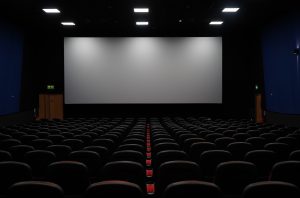Turning Living Rooms into Box Offices
Published on August 3, 2020, at 2:21 p.m.
by Katie Poedtke.
Since the coronavirus required stay-at-home and safer-at-home regulations, many buildings stand empty, waiting for people to flood their halls and make use of them again. One of these structures? The movie theater.

As movie theaters shut down across the nation, big players in the movie industry decided to delay movie releases. There is no reason to put a relatively expensive motion picture on the big screen if the audience is absent. The other options to continue to be competitive in the industry — early releases and re-releases.
Early releases
Some streaming services such as Disney+ and Amazon have side-stepped the theater closures by releasing their movies early. These releases also include movies that were in theaters for a short amount of time before COVID-19 disrupted operations.
Disney+ kick-started the movement of early releases during the pandemic when it made Frozen II available on its streaming site on March 15. The movie was not expected to be released to the public until June, but the Walt Disney Co. decided to help lift people’s spirits during these trying times by bringing some magic into their own homes.
Releasing movies to the public early doesn’t just offer about 120 minutes of hopeful distraction from our current circumstances — it reminds the public about what the company stands for. Disney’s example, and the example of those who followed suit, reinstated its company’s values and stuck by them to provide for its consumers. Early releases can be risky, but audiences won’t forget the feeling of gathering together to watch a family favorite. That warm feeling will translate to consumer loyalty for the brands that pursue this option.
Some other notable early release movies for your next binge include the following: “The Invisible Man,” “Onward,” “The Way Back,” “I Still Believe” and “Emma.”
Bringing back the classics
Netflix has a different approach to bringing excitement into movie-watchers’ lives during the pandemic. The streaming service releases schedules to the public of when new additions will be available, and the month of May has some nostalgic listings.
As of May 1, Netflix released classic movies from the past, including “Back to the Future,” “Back to the Future Part II,” “Willy Wonka & the Chocolate Factory,” “Charlie and the Chocolate Factory” and the “Jarhead” trilogy.
Bringing movies from decades ago is a great strategy. Rewatching movies from the childhoods of several generations brings Netflix’s audiences back home, even if they are physically distant from it. Reminding people of the past can bring hope for the future, that things will go back to a version of normal one day. The comfort that Netflix provides will resonate with its publics, and, once again, consumer loyalty and trust in the brand will continue to grow.
Especially during times like these, it is imperative to continue to cultivate and create. By refusing to remain stagnant, a brand can actively keep its consumers engaged and reiterate its values. For the movie industry and streaming services, turning living rooms into box offices offered the perfect opportunity to maintain connection with their respective publics.




